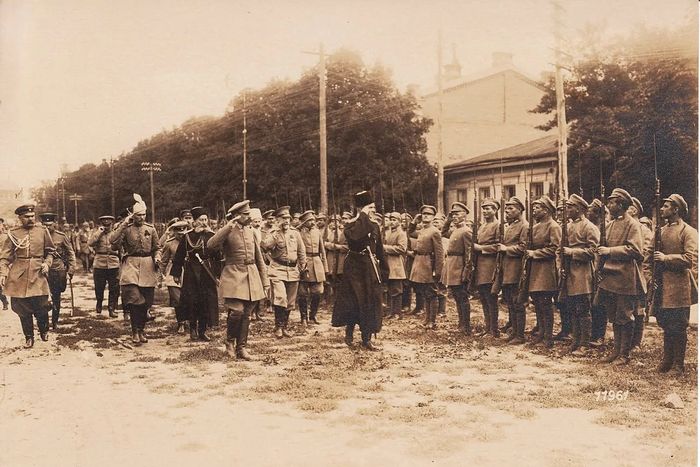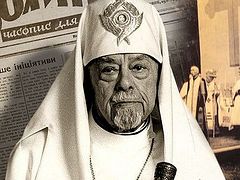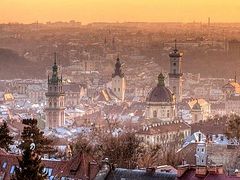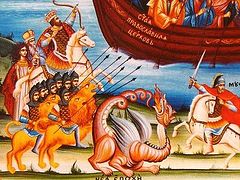Introduction by Matfey Shaheen: This is a translation of an interview from Pravoslavie.ru with the Doctor of Historical Sciences and Professor Moscow State Pedagogical University Vasily Zhanovich Tsvetkov. The topic of discussion was the Civil War in Ukraine one hundred years ago. That conflict, much like the current Ukrainian Church Crisis, is often oversimplified in the West as a nationalistic struggle between Russians and Ukrainians.
In history and reality, framing complex issues effecting millions of people as “Us vs. Them” is often expedient for demagogues, or otherwise employed by outside powers using divide and conquer strategies, but does not help to understand or resolve the situation. These days, when issues have become so polarizing, and everyone seems to be on one side or another, objectivity and sobriety can be completely lost.
These great national and multinational, religious and cultural questions are often titanic issues, as nuanced as they are deeply passionate and emotional for those involved, as well as extremely politized, and it is therefore very difficult to find objective information.
In this article, we discuss how the Ukrainian Civil War was not simply a conflict of Russians vs. Ukrainians, or Ukrainians vs. Ukrainians, or Loyalists vs. Communists, but often a Machiavellian struggle between several competing powers, both within Ukraine and from multiple other nations, and the opinion of the actual common people living in Ukraine at the time is rarely discussed.
We explore how early attempts at Ukrainian independence were more geared towards autonomy within a Russian world, and more cultural than nationalistic, and how later on the conflict was absorbed within the greater red terror. Many may be surprised to find that the Bolshevik authorities who seized power in Russia often supported Ukrainian nationalism or independence as a tool against loyalists to the Russian crown, many of the latter being Ukrainians themselves who saw Ukraine as an intricate part and spiritual center of Holy Rus’. Also, while nationalistic matters played a factor in the Civil War in Ukraine, it was also worth noting how for simple people living in Ukraine, it was often the social policy of the powers in question towards them; for example, if peasants would be given land to farm, which mattered to them far more than which national ideology to support. Issues of which high culture to promote, or which language to speak were primarily fought over by the elite, as the peasants were generally satisfied enough with whichever authority they believed would benefit them the most, or at least treat them the most humanely.
At times, multiple powers and governments were spread across Ukraine each with their own policies, and even foreign armies such as the Germans, Austro-Hungarians, and Polish, to name a few, were involved in this conflict, each with their own interests.
Because the background of this historical conflict may help provide more context with the current issues in Ukraine, we felt it would be valuable to translate it.
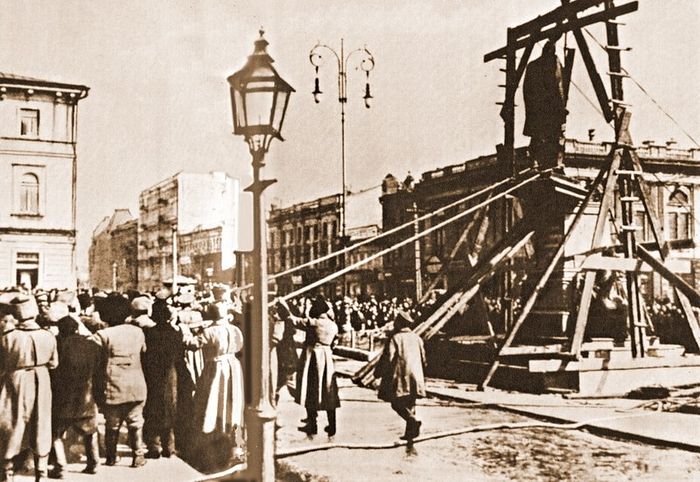 Toppling the monument to Stolypin in Kiev, March 15, 1917
Toppling the monument to Stolypin in Kiev, March 15, 1917
—At what time in Ukraine did the desire arise to separate from Russia, and to what did it culminate in 1917?
—The desire to separate from Russia and create an independent state in Ukraine was absent for a very long time. We can speak about a certain striving to preserve national culture, find a national identity, develop interesting traditions in folklore and literary works, but at the same time, Slavic culture in its broad understanding—as Great Russian, Little Russian [Ukrainian—Trans.],1 and Belarussian cultures—was seen as a single whole. It is valuable to call to mind the example of Taras Hryhorovych Shevchenko or Nikolai Vasilyevich Gogol.2 In a word, there was no talk of any exclusive culture, separate from the general Russian one.3
The rise of Ukrainian separatism dates back to the beginning of the 20th century; in part, it was due to the desire of a number of Ukrainian public figures to make a career out of it. For example, the writer and revolutionary Vladimir Vinnichenko, who became the first prime minister of the Ukrainian People’s Republic, the historian Mikhail Hrushevsky, the well-known Simon Petlyura, and others.
—When were they speaking openly about secession from Russia?
—Separation from Russia in no uncertain terms and the creation of an independent state began to be widely discussed only towards the end of 1917 and the beginning of 1918. Prior to this, talk was mainly about autonomy within Russia. But even the movement for large-scale autonomy naturally required elite influential groups and leaders. The leaders mentioned above—Hrushevsky, Vinnichenko, and Petlyura—filled the role of such an influential group. In the model of broad autonomy, they saw the opportunity for increased political status; but even after February of 1917 Ukraine did not yet claim complete independence, and even the word “Ukraine” itself was rarely spoken.
 Ukraine at the moment of the Declaration of independence by the Central Rada in January 1918.
Ukraine at the moment of the Declaration of independence by the Central Rada in January 1918.
The territorial borders of Ukraine appeared mainly within nine governates, but it should be remembered that the governate borders were not established by Hrushevsky or Petlyura. They were drawn up in the 18th-19th centuries, and not because ethnically united Ukrainians lived there, but rather the determining factors were administrative and economic considerations. It was believed possible to achieve the preservation of Ukraine within a democratic, renewed Russia, with broad political and cultural autonomy.
—But when was there talk about independence itself, and why? What promoted the striving towards independence?
—The October Revolution and the coming to power of the Bolsheviks in Petrograd. On November 7/20, 1917, the Central Rada4 proclaimed the Ukrainian People’s Republic. This was two weeks after the Bolsheviks came to power. And from then on, the talk was already about creating an independent state.
Earlier, the Central Rada expected to come to an agreement with Kerensky on the degree of its autonomy. And Kerensky was ready for this. True, his promises of autonomy were made even before the relevant decisions of the Russian Constituent Assembly. This became in particular one of the causes of the political crisis in July of 1917, when the Cadets, who positioned themselves as supporters of a “united and indivisible Russia,” resigned from the Provisional Government, saying that Kerensky had no right to make statements about the future of Ukraine without the sanction of the Constituent Assembly.
But after the Kerensky Provisional Government bid everyone farewell and long life [i.e., a Russian phrase meaning they were doomed, terminated, gone—Trans.]5, negotiations with the Central Rada on the part of the Petrograd Council of People’s Commissars were practically not conducted. Lenin counted on Soviet power in Ukraine, on the support of the workers of Kiev and especially Kharkiv. But in the Central Rada, they considered that at that moment, nothing connected them with Muscovy and Petrograd anymore, and so the time had come to declare the creation of an independent state.
Who fought with whom in Ukraine?
—When did the Civil War began in Ukraine, and what were its specific characteristics compared to the Civil War on the rest of the territory of the former Russian Empire?
—First of all, it should be noted here that Ukrainian separatism was supported not only by the elite like Hrushevsky, Vinnichenko and Petlyura, but also by specific money: financial “injections” that were carried out by the Germans and especially the Austrians. German and Austrian intelligence subsidized the separatists, in the hope that even simply in the form of maximum autonomy [as opposed to total independent statehood—Trans.], it would weaken central Russian authority. And this was in fact already a provocation of civil war, but from the outside, from Germany and Austro-Hungary. And above all, of course, it was Austro-Hungary, because it was interested in expanding its territory at the expense of the Carpathians, Transcarpathia, and possibly even Kiev. As you know, the structure of Austro-Hungary included Slavic lands (Czech Republic, Slovakia, Slovenia, etc.). It was believed that part of Ukraine could also be included there. It is no coincidence that the Austrian General Staff actively funded Ukrainian separatist organizations, and conducted propaganda among prisoners of war—natives of Little Russian governates.6
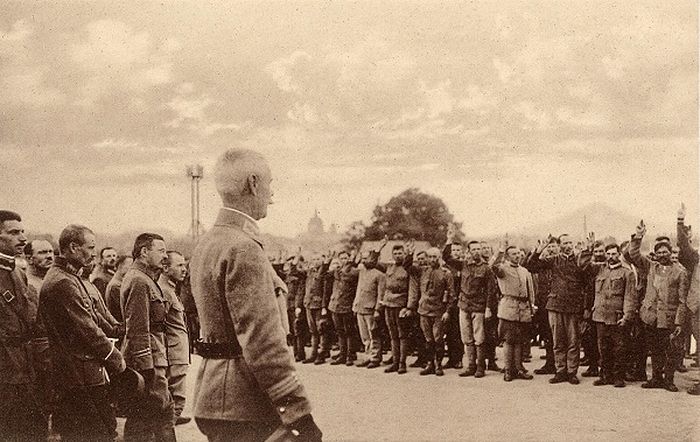 Prisoners of war of the former Austro-Hungarian army of Ukrainian nationality.
Prisoners of war of the former Austro-Hungarian army of Ukrainian nationality.
After February of 1917, under the conditions of the total collapse of the former Russian state, anti-Semitic sentiments spread quite widely and pogroms began. It was an element of protest, the desire to look for “enemies”, or even simply to rob. But this happened not only in the Ukraine, but also in other governates. The general processes of the fall, division, and repartition were everywhere. The only question was who led them, who was the most active.
—And so, who were the most active in pogroms?
—According to statistics, most of the pogroms occurred on the territory of Right Bank Ukraine [the western-central side of Ukraine when looking at a map—Trans.]7, where the forces of Petlyura were situated. Here is remarkable fact: Petlyura, already in exile in Paris, was killed by a certain Samuel (Sholem) Schwarzbard, a Jewish poet and anarchist. Schwarzbard stated that the murder was an act of revenge for the Jewish pogroms of 1918-1920. Interestingly, a French court acquitted Schwarzbard. By the way, several streets in Israel today bear his name.
Ukrainian parties in many respects copied the “all-Russian” parties. Take, for example, the Ukrainian Bolsheviks—these were the Left Social Revolutionaries, whose print organ was called “Struggle” (therefore they were also called “Strugglers”). There were also Ukrainian parties of socialist revolutionaries and socialist federalists. There were Ukrainian Mensheviks too. Among the right you could name the “Union of Bread Growers”, “Union of Landowners.” These parties were essentially repeating Russian slogans: democratization of power, the republican form of government, etc.
The nationalist factor made itself known very strongly on the Right Bank of the Dnipro (Dneipr) River, among the local intelligentsia. And in Left-Bank Ukraine—in the Poltava and Kharkiv provinces—it manifested itself much less. In New Russia8, that is to say in the Yekaterinoslav, Taurida, and Kherson governates, it almost didn’t appear at all. New Russian rebels led by Nestor Makhno did not position themselves as some kind of Ukrainian national liberation movement, but as an anarchist movement, creating an entirely new form of social structure—the Republic of Free Soviets.
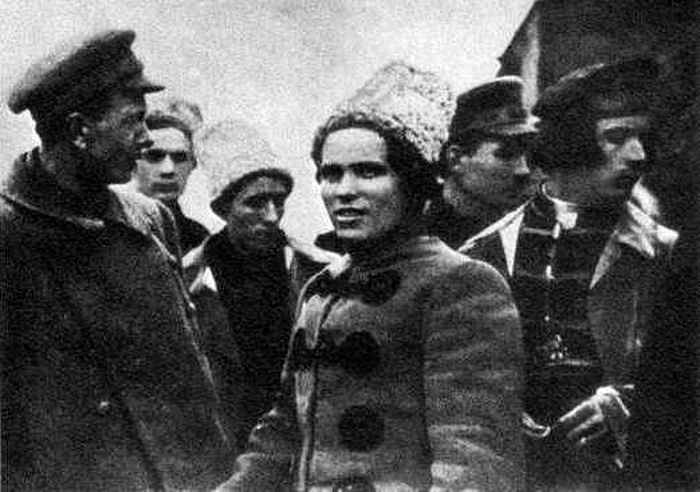 Nestor Makhno and his supporters, 1919.
Nestor Makhno and his supporters, 1919.
—Really? But… wasn’t Makhno a nationalist?9
—Not at all. In Gulyai-Pole, which is in the Melitopol uyezd10 of the Taurida governate, separatist sentiments were very week. They practically didn’t even know the Ukrainian language. But in the western governates, separatism grew; however it must be remembered that prior to 1917, all inhabitants of the Ukraine11 were subjects of the Russian Empire.
—Who were the main acting powers or armies in the civil war in the Ukraine?
—Four structures can be distinguished here. The first structure is the Red Army or the Red Guards, established on November 30, 1918.
—That’s so late, a year after the October revolution in Petrograd.
—Before that there were partisan detachments, which were notably formed along the border zone with Russia, in the Bryansk and Lgovsky uyezds near the cities of Ostrogozhsk, Glukhov, and Chernigov. Among the most famous, the “Red Cossacks”12 should be noted, under the command of Nikolai Schors. They fought mainly against the forces of Petlyura.
The second structure were the units of what was called the “Ukrainian State”, or the army of Hetman Pavlo Skoropadsky. In truth, it could be called an “army” only very conditionally, since the German occupation authorities, which supported the Hetman, did not allow him to create full-fledged armed forces. The Hetman confirmed the independence of Ukraine after the coup, which occurred with the active assistance of the Germans. And although Skoropadsky planned the creation of eight army corps, in reality, he managed to form only three infantry divisions.
He modeled his forces after the Russian Imperial Army (after all, he himself was a Tsarist General). Many things in their formation and charter were taken from the pre-revolutionary past. We can call to mind the junkers13 described by Bulgakov in his famous book “The White Guard”. It is no coincidence that most of those officers who served with Skoropadsky later transferred to Denikin’s [White] Army [after the fall of the Hetman.—Trans.].
The third structure in the civil war in Ukraine was the army of the Ukrainian People’s Republic, in particular, the Sich Riflemen, or “Sichevniki”. They were basically natives of western governates. Petlyura, the Ukrainian People’s Republic minister of war, relied on so called “Atamans”; and “Atamans”, in his understanding, was an analogy with the Zaporizhian Sich, and Zaporizhian Cossacks. Unlike the Hetman’s army, Petlyura’s army seemed to continue the traditions of the “democratic army” of the 1917 period. It’s significant that they wore the uniform of the Austro-Hungarian army, but simply with their own insignia.
The fourth military structure in the Ukraine was the rebel army of Nestor Makhno and commanders related to him. This was a very specific army, and operated mainly in New Russia, with the principles of internal self-government, elected command staff, etc. This is perhaps, in its purest sense, an environment of uprising—a rebel movement.
The Course of War
—Who fought with whom, and what was the course of war as a whole?
—It was in a constant state of regime change. In one governate, there was one certain regime, and in another governate, there could be a completely different regime at the exact same time.
In short, it all begins with the Central Rada, which proclaimed the independence of Ukraine. Then, the forces of the Rada began military operations against the forces of the Red Guard, who were advancing on Kiev. They were invading so actively and successfully, causing the Rada to retreat to Zhytomyr and address the Germans for support. Having allied with the Germans, the Rada begins to supplant the Reds with their help and support. Units under the command of Vladimir Antonov-Ovseyenko retreated, and in January of 1918, two Soviet republics were created—the Odessa Soviet Republic, and the Donetsk–Krivoy Rog Soviet Republic. Their history is short-lived, and they were largely oriented towards Soviet Russia.
As a result, the Central Rada asserted itself in the territories under German control. Kharkov was then also under German control, although at first this city was the Soviet capital, and Kiev could have at that time been called the anti-Bolshevik center. But then a change of government took place, and Hetman Skoropadsky came to power. The forces of the Ukrainian People’s Republic retreated to Volhynia. The rebel movement of Makhno began against the Germans and the Hetman. This was the spring-summer of 1918.
Then, when the German troops left Ukraine, after the end of the First World War, the Red Army’s offensive resumed, which passed through Kharkiv and Donbass to Kiev. At the same time, the forces of the so-called Directorate of Ukraine were also opposing the Hetman. The Hetman’s forces were defeated, and he renounced power in November of 1918. The forces of Petlyura occupied Kiev. This is all well described by Mikhail Bulgakov.
In 1919, war began again—between the Ukrainian People’s Republic and the Ukrainian Socialist Soviet Republic [abbreviated Ukrainian SSR, as to not be confused with the USSR—trans.]. The Ukrainian SSR was created under the auspices of [Soviet-occupied] Moscow14 [meaning the Bolsheviks in power, not Russia, see footnote 14.—Trans.], although Lenin alleged that there is no pressure on the republic, that it should not depend on Moscow. He took into account the nationalist factor, which was impossible to ignored or suppress.
In the spring of 1919, intervention troops landed in the south—these were the French in Odessa, and the Greeks in Sevastopol and in the Crimea. They fought against both the Petlyurites and the Ukrainian Red Army. Makhno at first did not recognize any of them, but in the end, he made an alliance with the Ukrainian Red Army and entered into its composition.
—And what of the White Movement?
—There wasn’t exactly a white movement in Ukraine at that precise time. As I already said, the remnants of Hetman Skoropadsky’s army joined with Denikin. Denikin began to advance in the spring of 1919, and there were battles throughout Donbass. Then with a swift blow, Denikin took Kharkiv, and in July of 1919, [the army.—Trans.] began to carry out the “Moscow Directive” No. 08878, in which General [Denikin] set the goal for the Armed Forces of South Russia to retake Moscow. The Whites conducted successful offensives in Kiev, Odessa, and Poltava, but at this time, Denikin was not fighting with the forces of Petlyura, but instead with parts of the Red Army, including divisions of the Ukrainian Red Army.
Denikin occupied Kiev in September of 1919, which he held until early December. Most of the territory of Ukraine at that time was under the control of the Armed forces of South Russia. Of course, the Ukrainian separatists had nothing to do here. For the Whites, even the word “Ukraine” did not exist, for example, Denikin began his appeal with the words “To the population of Little Russia.” The Whites tried to establish collaboration with local rebels, for example, when Ataman Struk15, who was operating near Kiev, was given a promotion to colonel, his rebels were included in the Armed Forces of South Russia, and he immediately “forgot” about the issue of the “Ukrainian nation” and began to swagger in parades.
But the “campaign for Moscow” ended in defeat, and the coup against the White Movement lead to the Soviets coming to power.
In 1920, Petlyura entered into an agreement with Poland, and supported the offensive of the Polish troops during the Soviet-Polish War. There were no White troops in Ukraine [at that time.—Trans.], with the exception of General Wrangel’s army, which in the fall of 1920 fell back to the borders of the Yekaterinoslav Governorate.16 The main confrontations were between the Red Army and the Polish Army.
After the end of the Soviet-Polish War, and the conclusion of the Peace of Riga, the Ukrainian People’s Republic, as it positioned itself, ceased to exist in actuality. Its government emigrated.
—And what happened with Nestor Makhno and his rebels?
—Makhno began to act independently of the Red Army, even though prior to this he was actively supporting its actions against Denikin. After the defeat of Wrangel’s army, Makhno became an adversary of Soviet power. He was given an order to disarm, but he did not obey, and in the first half of 1921, his troops were liquidated. The affair ended with Makhno leaving with the rest of his forces abroad, and the authority of the Ukrainian SSR was established in the end.
Lenin was afraid to pressure the locals
—What was the overall position of Soviet Moscow17 on the Ukrainian issue?
—Lenin wrote a major article, “A Letter to the workers and peasants of Ukraine on the occasion of the victory over Denikin”. Almost all of it is devoted to how important it is to take into account the nationalist factor when creating the Ukrainian SSR. The idea was that if the workers and peasants of Ukraine agreed that an independent Ukrainian republic should be created, then it is so, and if not, then it means no. The decision was formally given to the local organs of Soviet power.
 The Red Army after the entry into Kiev, summer 1920.
The Red Army after the entry into Kiev, summer 1920.
—Do you think he wrote this sincerely?
—Why not? It was impossible to not consider the desire for autonomy, not to mention the separatist sentiments among part of the population. Lenin did not want to pressure the local, already Soviet, leadership. It pushed him to make a decision on an alliance with Moscow. And that congress Lenin wrote about, the 4th All-Ukrainian Congress of Soviets, an interesting decision was made in May of 1920, in Kharkov. It decided that the Ukrainian SSR would retain its independence and constitution, but at the same time become a member of the All-Russian Socialist Soviet Federative Republic. This can be called a kind of union state of Russia and Ukraine—all the more so since there was a unified People’s Commissariat acting, and there was a single military. And then, based on this decision, the USSR was created. In December 1922, the Soviet Union was proclaimed on the basis of the unification of four Soviet republics: Russia, Ukraine, Belarus and the Transcaucasian Federation.
—But wasn’t there a certain cunning guile from the position of Lenin? He understood that the backbone of the Ukrainian congress would be Communists, who would vote for unity simply because they are members of the same party. Or am I misrepresenting the situation?
—Naturally, there was an overwhelming majority of Communists. But it was also true that still remaining were [members of the party of] leftist Socialist Revolutionaries; in contrast, by the way, from Soviet Russia, where there were none of those leftist Socialist Revolutionaries remaining, they were already enemies [of the Bolshevik party—Trans.]18 But then again, within the Ukrainian Communist Party itself, there was a very strong movement for a completely independent socialist republic.
Lenin, considering the possible prospect of creating a future Union of Soviet Republics (on the global scale), believed that the formation of a union of officially independent republics would be much more successful than incorporating Ukraine into Russia. At that time, it was a fairly clever and justifiable political tool.
Could it then be said that the Bolsheviks succeeded because of their clever consideration of the nationalist factor?
I think that the nationalist factor was important, although not decisive, and by no means the only one. More important for the population of Ukraine was the solution of the land issue. The Bolsheviks took into account the serious mistakes that were made in Soviet Ukraine, in the first half of 1919, when collective farms and state farms began to be created on the basis of the former landowner estates, and the peasants practically did not receive land. At that time, so-called “Committees of Disadvantaged Villagers”19 were active, an analog [of the Russian] “Committees of Poor Peasants”20, which caused peasant resistance and the growth of rebellion.
The new land policy, which the Bolsheviks promised to pursue in Ukraine after 1919, suggested that individual peasant farms would be endowed with land, that they would not be united into collective farms, so that the peasants would see the advantages of the new government, which “helps” them. As [a propaganda tool], the idea of the possible return of landlords and repressions, which could happen if, theoretically “the white army was to win”, was actively used. And all this was much more understandable and relatable to local peasants than matters like the Ukrainian language, autonomy, or federalization. The latter was more important for the new Ukrainian, already Soviet, elite. These were, for example, the Chairman of the Council of People’s Commissars of Ukraine and People’s Commissar of Foreign Affairs Christian Rakovsky, the People’s Commissar of Justice and People’s Commissar of Education of Ukraine Nikolay Skrypnyk, Nikolay Podvoisky, Antonov-Ovseenko, and many other party and Soviet leaders. It was believed, as I noted above, that Ukraine would be in the orbit of Moscow’s influence, but without being absorbed by Moscow.


